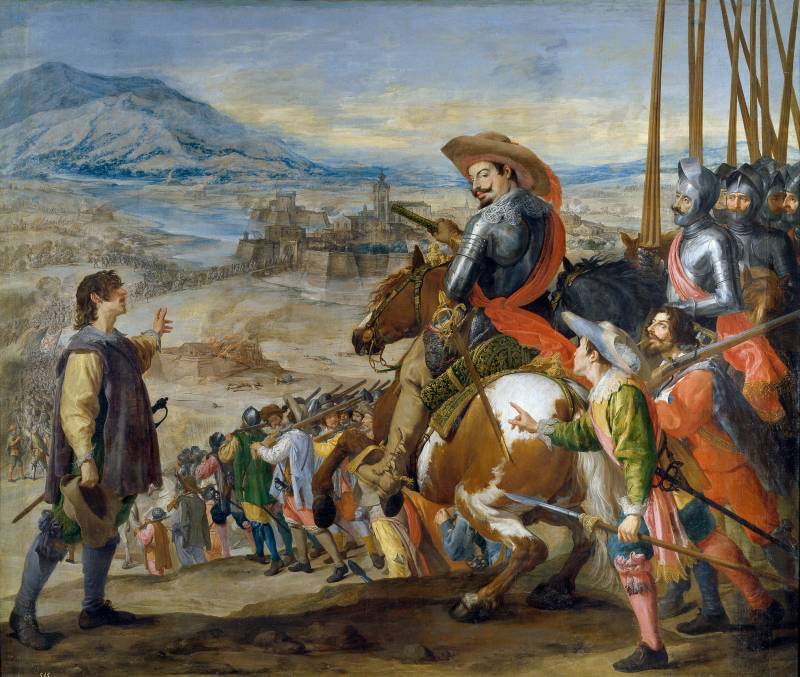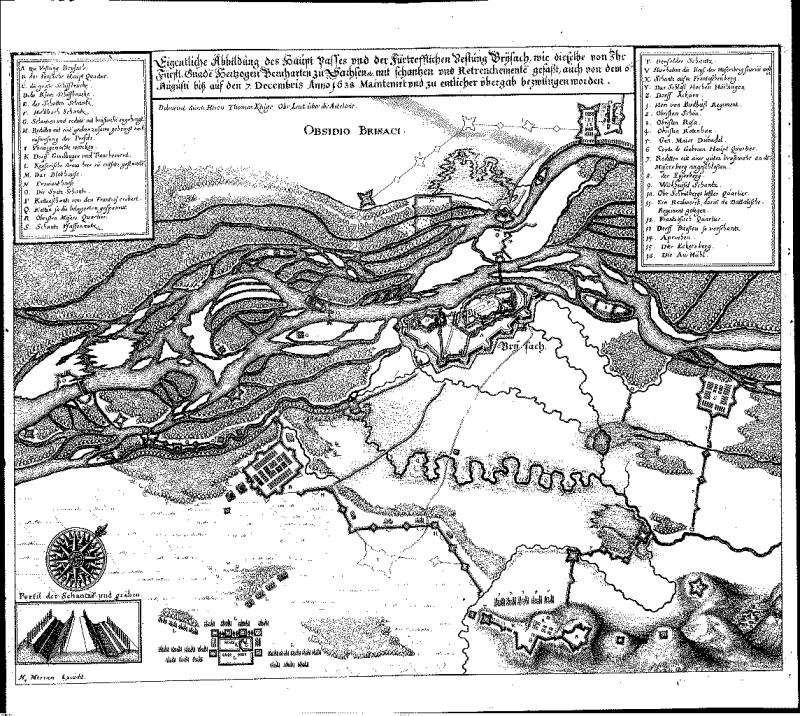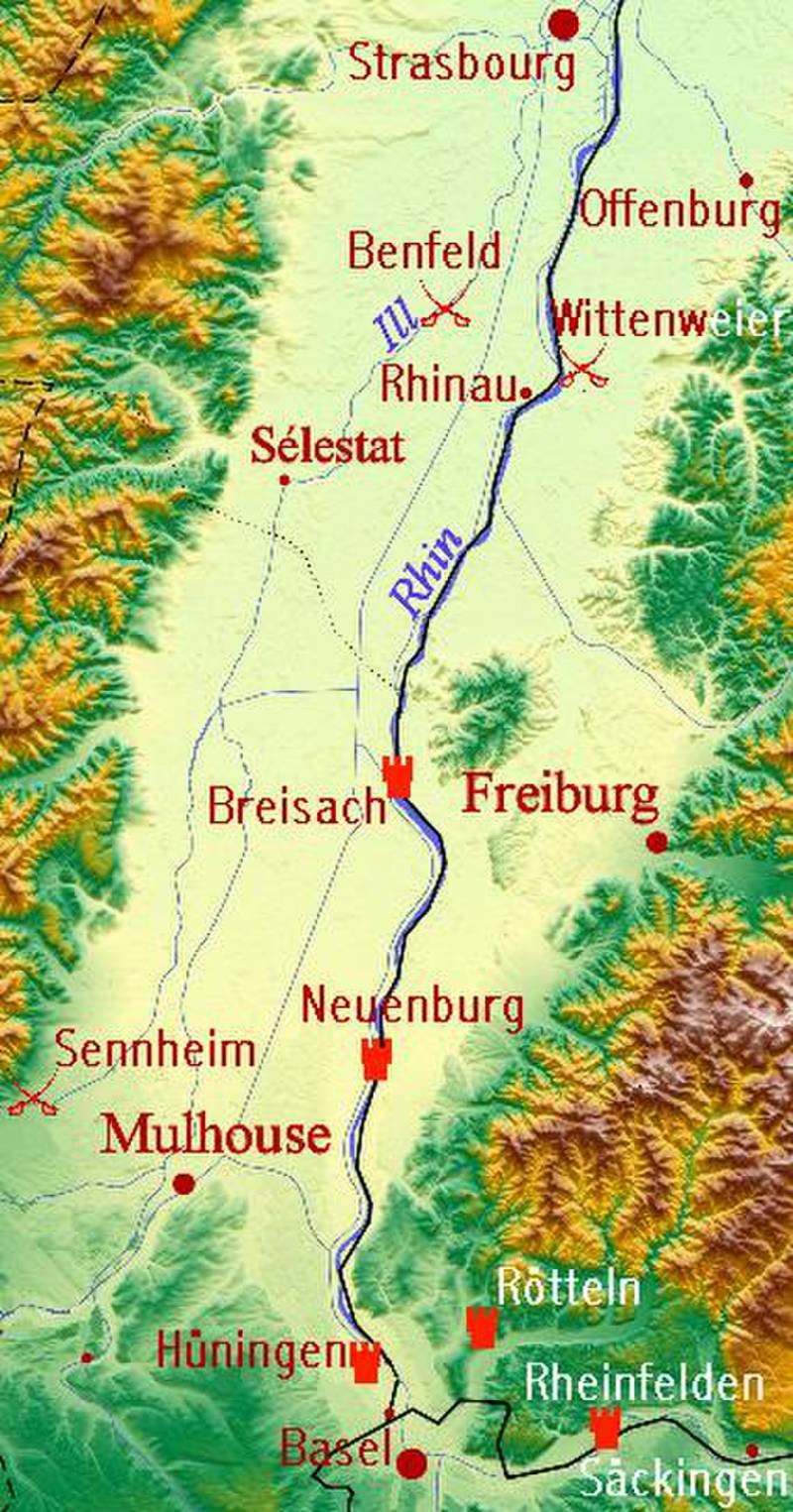The siege of Breisach: how the impregnable stronghold on the Rhine fell

In 1638, the French, Swedes and Weimar continued their offensive in Germany. On March 26 of the same year, the Battle of Reinfeld took place, where the head of the Protestants Bernhard of Saxe-Weimar with his troops defeated the Bavarian army of Johann von Werth. As a result, Bernhard and his allies continued their offensive: on 12 April they took Freiburg and continued to capture cities on the Rhine.
However, one could not speak of complete dominance on this river. The fact is that individual Austrian, Bavarian and Spanish troops still remained. In addition, Breisach, a stronghold of Catholics on the Rhine, was not captured.
Breisach is a fortress located on the right bank of the Rhine. It links the routes from Baden to Lorraine and Alsace, as well as the Spanish Road. The fortress was excellently defended: it was located on a high hill, surrounded by triple walls and deep ditches. Also from the left bridge to it was a stone bridge, which was well protected.
But the fortress had to be taken because, given its strategic position and capabilities, the imperials used it. And already in May, Bryzah was besieged.

Prior to this, there had been attempts to take Breisach before: in the summer of 1633, it was besieged by the Swedes under the command of Count von Salm, but by October the siege had already been lifted by the Spanish troops of Prince Gomez Figueroa. Now the Duke of Weimar had to besiege and take the fortress with the help of the auxiliary forces of the French and Swedes. It was obviously not easy: firstly, the fortress itself is well protected; and secondly, Catholics regularly tried to help the fortress from outside. And the Protestants hoped that they could take the fortress and that it would not happen like it did in 1633.
So, in May 1638, the troops of the Duke of Weimar laid siege to Breisach.
Siege
Their forces consisted of 6 infantry, 000 horsemen, 5 sappers and 800 guns under the command of Friedrich Kannofsky. The troops of the fortress governor Hans von Reinach numbered 400 infantry and had 25 guns, but they did not have enough food supplies, so without outside support they would not have lasted long.
With this in mind, on May 19, a detachment of Imperials under the command of Johann von Goetz arrived to help the garrison with food. Despite the resistance of the Protestants, he managed to break through to the fortress and deliver five hundred sacks of grain, but the detachment of Colonel Taubadel eliminated the breakthrough, and Goetz and his cavalry had to get out.
Realizing that the Imperials could once again make a breakthrough to the fortress, Bernhard of Saxe-Weimar strengthened the blockade of the fortress, but not completely, since from the end of May the defenders of the fortress began to receive food and ammunition along the Rhine from another important fortress - Basel.
But the siege continued, and in June the Weimar decided to reinforce the blockade again. In Neuenburg, a bridge was built across the Rhine and the islands, the river itself was blocked with chains. An attempt by the besieged to break the chains with the help of a firewall was unsuccessful. But on June 26, a convoy with food arrived in Braise from Kenzingen. And it, as subsequent events showed, was by the way.
In early July, a fire broke out in the fortress: hungry soldiers entered the food warehouse and accidentally set fire to gunpowder. As a result, the fire destroyed 40 houses and almost all the gunpowder and flour. Therefore, the defenders of the fortress were very lucky that they then brought provisions. But it didn't get any easier.
On 9 July, near Benfeld, Taubadel encountered seven Imperial cavalry regiments supported by Croats and Musketeers. But they were defeated, and Taubadel got trophies in the form of a thousand horses and 13 banners. However, already on July 14, the Duke of Weimar lifted the sieges of Kenzigen and Offenburg, and on July 28 returned to Freiburg. Also on July 23, fortifications were built upstream of the Rhine.
August
August was also busy.
On August 7, the Spanish-Austrian army of Frederico Savelli and Johann von Goetz, numbering 18,5 thousand people, left Offenburg and moved towards Breisach. The Duke of Weimar, having learned this, went out to meet him, having only 13 people. Opponents met near the city of Witten, the Catholics suffered a crushing defeat: out of the entire army, only 000 people returned to Offenburg.
Bernhard fell seriously ill and was forced to go to Colmar for treatment. He left Johann von Erlach in command of the siege army and Reinhold von Rosen in charge of the covering army. The Austrians again made an attempt to break through to the fortress with seven cavalry regiments, but again failed. The Protestants additionally built two pontoon bridges and blocked the Rhine with chains.
September
There were many small skirmishes in September.
The Croats tried to break through to the fortress, but failed.
On September 5, Kannofsky joined Rosen with a large force. He caught an enemy detachment of a hundred people in a narrow passage; as a result, 20 people were killed, and the rest fled, leaving provisions.
And on September 6, Rosen dispersed a larger detachment, the imperials lost 200 people killed and 60 wounded. But on September 10, 300 Catholics swam across the Rhine to reach the fortress.
On September 22, the Protestants in Offenburg captured a herd of 300 cows, but on the same day 400 Croats captured 200 horses in Neuenburg. They also got the Weimar command in this city.

October November
If in the previous months of the siege there were no particularly large attempts to release Breisach, then in October the imperials began to take the bull by the horns. They decided to attack from two sides: from Alsace to the fortress, Duke Charles IV of Lorraine should break through with ammunition, while the troops of Johann von Goetz were advancing from Tyrol. But failed.
Bernhard of Saxe-Weimar, lying in a hospital bed in Colmar, having learned about the offensive of the imperials, gathered his troops and marched towards the Duke of Lorraine, inflicting a defeat on October 15 on the plains of Tana. Then, taking Mühlhausen on October 19, he moved to Breisach, having received reinforcements in the form of 4 French Marshal Gebriand.
But on the same day, Goetz's army, united with the army of General Lambois and having a total force of 10 infantry and 000 cavalry, made an attempt to break through to Breisach. But then the troops of Bernhard and Gebrian came to the rescue.
As a result, the Imperials, with heavy losses, were thrown back behind Freiburg, and, having quarreled with each other, dispersed: one in Schaffhausen, the other in Waldkirch. The Duke of Weimar offered Reinach to surrender, but he proudly refused, declaring that if it were necessary to bake bread from oak bark, he would not surrender. But it was still very difficult for the besieged: on October 28, they were forced to leave the flashes, and on October 30, the last external fortifications of Breisach.
Meanwhile, Charles IV of Lorraine and Johann von Goetz developed a new plan: the duke was advancing on Colmar, and Goetz on Neuenburg. But the couriers were intercepted, and reinforcements arrived at the Protestants - 9 people of Duke Henry II of Longueville. As a result, the Imperials were defeated and driven back to Waldshut. The Duke of Lorraine, learning of the defeat, remained where he was.
On November 5, Henry II de Longueville defeated the troops of Frederico Savelli and drove them to the Moselle River. Rainakh again received an offer to surrender the fortress, but he again refused.
Surrender
On December 2, Johann von Goetz was accused of colluding with the Duke of Weimar and arrested, the charges against him were dropped only two years later. The next day, a powder tower exploded in the fortress, and a large gap appeared in the wall. But on the advice of Erlach, Prince Bernhard did not launch an assault, fearing heavy losses.
Out of desperation, Hans von Reinach began negotiations with General Johann von Erlach, and on December 17 the fortress was surrendered.
The Duke of Weimar, having learned that his captured soldiers were being starved, did not want to sign the surrender, but his officers persuaded him to do so. On December 19, the last 400 completely exhausted defenders of the fortress with flying banners, led by Reinach, Chancellor Folmer and Colonel Asher, left the fortress and headed for Strasbourg.
As a result, the Protestants received all the artillery of the imperials and the rest of the military equipment. They also received over a million thalers, which made it possible to recoup all the costs of the siege. Protestants lost 8 people, Catholics twice as many.
The French and their German allies were left with a ruined fortress, which was once an impregnable stronghold on the Rhine. In Breisach, out of 4 inhabitants, only 000 survived, food was very expensive: 150 pounds of bread and one measure of wine was equal to a diamond ring. Cemeteries had to be guarded, as the dead were eaten. The watchmen who guarded the cemetery were bribed, and the farmers who tried to smuggle provisions into the fortress were hanged in front of the besieged. The prisoners suffered greatly, of which 3 died of starvation, and 30 were eaten.
Information